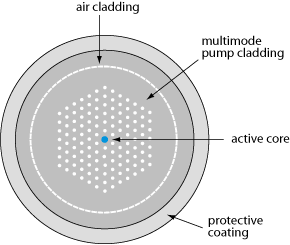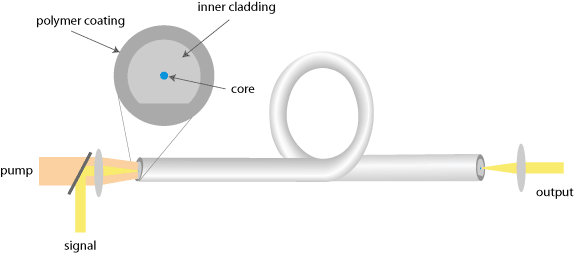For particularly high powers, the core area needs to be large enough, because the light intensity will be very high, and another reason is that the ratio of cladding to core area in double-clad fibers is large, resulting in low pump absorption. When the core area is on the order of several thousand square micrometers, it is feasible to use a single-mode fiber core. Using multimode fiber, when the mode area is relatively large, the output beam of good quality can be obtained, and the light wave is mainly the fundamental mode. (Excitation of higher-order modes is also possible to some extent by winding the fiber, except for the case of strong mode coupling at high powers) As the mode area becomes larger, the beam quality can no longer remain diffraction-limited, but compared to For eg rod lasers operating at similar power intensities, the resulting beam quality is still quite good.

There are several options for how to inject very high power pump light. The easiest way is to pump the cladding directly at the fiber port. This method does not require special fiber components, but the high-power pump light needs to propagate in air, especially the air-glass interface, which is very sensitive to dust or misalignment. In many cases, it is preferable to use a fiber-coupled pump diode, so that the pump light is always transmitted in the fiber. Another option is to feed the pump light into a passive fiber (undoped) and wrap the passive fiber around the doped fiber so that the pump light is gradually transferred into the doped fiber. There are some ways to use a special pump combination device to fuse some pump fibers and doped signal fibers together. There are other methods based on side-pumped fiber coils (fiber disk lasers), or grooves in the pump cladding so that the pump light can be injected. The latter technique allows for multi-point injection of pump light, thus better distributing the thermal load.

Figure 2: Diagram of a high-power double-clad fiber amplifier setup with pump light entering the fiber port through free space. The gas glass interface must be strictly aligned and clean.
The comparison between all the methods of injecting pump light is complicated because many aspects are involved: transfer efficiency, brightness loss, ease of processing, flexible operation, possible back reflections, light leakage from the fiber core to the pump light source, Keep the choice of polarization etc.
Although the recent development of high-power fiber optic devices has been very rapid, there are still some limitations that hinder further development:
The light intensity of high power fiber optic devices is much improved. Material damage thresholds can now usually be reached. Therefore, there is a need to increase the mode area (large mode area fibers), but this method has limitations when high beam quality is required.
The power loss per unit length has reached the order of 100W/m, resulting in strong thermal effects in the fiber. The use of water cooling can greatly improve the power. Longer fibers with lower doping concentrations are easier to cool, but this increases nonlinear effects.
For not strictly single-mode fibers, there is modal instability when the output power is greater than a certain threshold, typically a few hundred watts. Mode instabilities cause a sudden drop in beam quality, which is the effect of thermal gratings in the fiber (which oscillate rapidly in space).
Fiber nonlinearity affects many aspects. Even in a CW setup, the Raman gain is so high (even in decibels) that a significant portion of the power is transferred to the longer wavelength Stokes wave, which cannot be amplified. Single-frequency operation is greatly limited by stimulated Brillouin scattering. Of course, there are some measurement methods that can offset this effect to a certain extent. The ultrashort pulses generated in mode-locked lasers, self-phase modulation will produce a strong spectral broadening effect on them. In addition, there are other problems of injecting nonlinear polarization rotation.
Due to the above limitations, high power fiber optic devices are generally not strictly considered scalable power devices, at least not outside the achievable power range. (Previous improvements were not achieved with single power scaling, but with improved fiber designs and pump diodes.) This has important consequences when comparing fiber laser technology to thin disk lasers. It is described in more detail in the entry Laser Power Calibration.
Even without real power scaling, much work can be done to improve high-power laser setups. On the one hand, it is necessary to improve the fiber design, such as using a large fiber mode area and single-mode guidance, which is usually achieved by using photonic crystal fibers. Many fiber components are very important, such as special pump couplers, fiber tapers to connect fibers with different mode sizes and special fiber cooling devices. Once the power limit of a certain fiber is reached, composite beams are another option, and suitable fiber setups exist to implement this technique. For ultrashort pulse amplifier systems, there are many approaches to reduce or even partially exploit the nonlinear effects of optical fibers, such as spectrum broadening and subsequent pulse compression.
